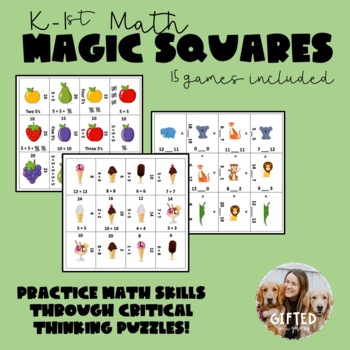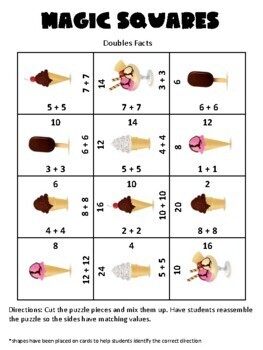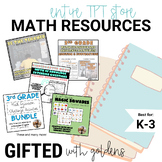Magic Squares - K&1 Critical Thinking Challenge Math Puzzles
Gifted with Goldens
371 Followers
Grade Levels
PreK - 1st
Subjects
Resource Type
Standards
CCSSK.CC.A.2
CCSSK.CC.C.6
CCSSK.CC.C.7
CCSSK.NBT.A.1
CCSS1.NBT.B.3
Formats Included
- PDF
Pages
10 pages
Gifted with Goldens
371 Followers
What educators are saying
These magic square puzzles are perfect for my gifted classes. I used them with first graders and now with my gifted kindergarten. Thank you!
I used this with my advanced students to provide a challenge to them during small group time. Thank you!
Also included in
- Are you a Gifted Teacher that works with many grade levels looking for a large supply of MATH resources?This bundle would be perfect for you! BEST PART? It will continue to grow and include ALL FUTURE Math Resources! **Make sure to purchase it NOW and receive all future notifications to re-downloadPrice $100.00Original Price $132.50Save $32.50
Description
MAGIC SQUARES
15 Games Included!
Perfect for higher level math students in grades K-1 needing a challenge. These puzzles allow students to practice the same math skills, but include a critical thinking aspect. Students will rearrange the puzzle pieces to create a 3x4 square where all values match.
Great for: small group extensions, independent practice, center work, teamwork challenges, etc!
Skills included:
- Doubles facts
- 5's facts
- Greater than, less than
- What comes next - counting by 1's, counting by 2's, counting by 1's, 2's and 5's
- 10 more, 10 less
- Adding within 20 (3 puzzles)
- Adding 2 digit with 1 digit
- Subtracting within 10
- Subtracting within 20
- Counting pennies and nickels
- Counting all coins
Total Pages
10 pages
Answer Key
Included
Teaching Duration
N/A
Report this resource to TPT
Reported resources will be reviewed by our team. Report this resource to let us know if this resource violates TPT’s content guidelines.
Standards
to see state-specific standards (only available in the US).
CCSSK.CC.A.2
Count forward beginning from a given number within the known sequence (instead of having to begin at 1).
CCSSK.CC.C.6
Identify whether the number of objects in one group is greater than, less than, or equal to the number of objects in another group, e.g., by using matching and counting strategies.
CCSSK.CC.C.7
Compare two numbers between 1 and 10 presented as written numerals.
CCSSK.NBT.A.1
Compose and decompose numbers from 11 to 19 into ten ones and some further ones, e.g., by using objects or drawings, and record each composition or decomposition by a drawing or equation (e.g., 18 = 10 + 8); understand that these numbers are composed of ten ones and one, two, three, four, five, six, seven, eight, or nine ones.
CCSS1.NBT.B.3
Compare two two-digit numbers based on meanings of the tens and ones digits, recording the results of comparisons with the symbols >, =, and <.






